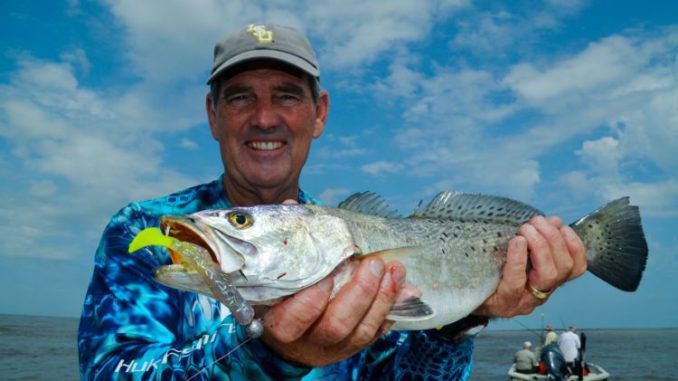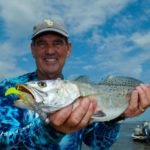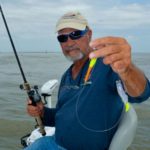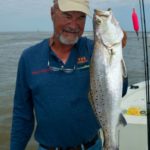
Live bait will certainly produce bites, but these trout masters understand soft-plastic lures will catch big specks. Here’s all you need to know to mimic their success.
The quest for the perfect speckled trout fishing lure never seems to end. In the early 1970s, when I broke into the fishery, it was dominated by lead-headed shad rigs, Mr. Champ spoons, Bingos, Plugging Shorty Shrimp, and MirrOlures.
The big game changer came in the 1970s with the invention of soft-plastic, split-tail beetles. They annihilated sales of shad rigs and, because of their versatility, sales of hard plugs and spoons became sluggish.
New lure types and brands have proliferated in the last two decades, and live-bait fishing is now often treated as the all-time cure-all for having to go work to find fish.
Still, soft plastics on jigheads never seem to go away and are likely still to be the most-cast bait for speckled trout and redfish.
I made up my mind to thumb a ride to Venice with two of the greatest plastic-casters in Louisiana history: Dudley Vandenborre and Ed Sexton.
I wanted to see if they do anything magical or if their success is due to just plain hard work.
I woke up at 4 a.m. to a pot of fresh coffee in Sexton’s Port Eads houseboat.
“Gee,” I thought, “if I’m sleeping where the fish sleep, why get up so early?”
But I didn’t say anything.
“Let’s start at the wall,” said Sexton, more in suggestion than direction to Vandenborre.
‘The wall,’ for those unfamiliar to Venice fishing, is a poured concrete wall extending along the eastern side of South Pass straight into the Gulf. Limestone jetty rocks were added around and on top of the wall.
The wall is invisible now. Coastal subsidence took care of that around the turn of the millennium. It just slowly sank beneath the waves, a millimeter at a time.
But it is still there, as are the rocks. What makes it work for fishing is that it keeps the fresh water coming down the pass channeled. While the muddy water from the pass spreads out and covers the surface behind the wall, clear, relatively salty trout-holding water very often still lies beneath the ugly water at the surface.
It was still dark when Sexton piloted the boat around the red beacon just beyond the end of the wall and hooked around behind it.
It wasn’t pretty. A big ground swell was rolling from the Gulf from yesterday’s blow.
The ugly, bucking water didn’t cause either man to blink an eye. Sexton moved to the bow and hunkered down on his patented, low, squatty bow seat near the trolling motor.
Vandenborre worked the rest of the boat.
Sexton started off with a blue moon Deadly Dudley Straight Tail, while Vandenborre put on a blue moon Terror Tail. Both were using round, unpainted, 3/8-ounce jigheads and both lures were 4 5/8 inches long.
They cast as close as possible to where they projected the submerged wall to be, waited for the lure to sink in the deep water and then worked it back by slowly, bouncing it through the big rocks tumbled at the wall end.
They hung up a lot.
Sometimes they could jiggle the lure free, prompting Sexton to state that often a trout will take it as soon as the lure comes loose.
Still, they lost a lot of baits.
“I hate this PowerPro,” grunted Vandenborre, while trying to break his line off.
He had to wrap the tough line around his reel handles to get enough purchase to break the line.
As they retied jigheads, they tried various colors: avocado, shrimp cocktail, purple and chartreuse (what Sexton called LSU color), among others.
By 6:20 a.m. they still hadn’t had a bite.
“In a few minutes we’ll go to the beach,” Sexton muttered. “This is a funny place. I’ve caught nothing, left and came back two hours later, left again, then came back and hit them.”
“I’ve never figured them out.”
Vandenborre said it’s probably better that there’s some mystery to the process.
“Having things figured out can be a disadvantage,” he said with a chuckle. “Sometimes in Lake Pontchartain, I know right when they are going to bite — right at the end of the tide. I may have to stay there to hold my spot, and I have to keep my (charter) customers occupied for four hours.
“Then it’s 50 fish in 30 minutes.”
At 6:55 a.m., they were still there. Their patience was incredible. Trout fishermen have a reputation for ants in their pants — run and gun until they find the fish.
“I guess it’s because we have seen it so many times — nothing, nothing, and then all of a sudden they turn on,” Vandenborre explained.
His fishing partner agreed.
“Knowing that you have caught big fish in a spot is part of it,” Sexton said. “If this were a new spot that someone had just told us about, we would have left already.”
Finally, they each caught a small but legal redfish.
Vandeborre held his up for examination.
“Well, one fish for 200 casts,” he lamented. “Outside of baseball players, (big trout fishermen) have to have statistics — how many casts per fish.”
At 7:15 a.m., Vandenborre put up his rod.
“Are you ready to go?” he asked.
They crossed the mouth of the pass and headed west along what passed for a beach, and hooked around the end of it.
They fished behind the beach, in essentially what passed for an extension of Coast Guard Cut.
The water was shallow — 3 to 5 feet — so here they shifted to corks and downsized their jigheads to ¼-ounce models.
Sexton’s cork was a primitive, wire, rattling cork made by Comal Tackle Co. that he called a cigar cork because of its shape.
“I can’t find them around here anymore,” he grumbled. “I’ll have to call Texas and order some.”
Vandenborre opted for an elongated Boat Monkey cork, but with a weight.
“You can throw it a mile into the wind with that weight,” he explained.
“I don’t like the weight,” Sexton countered. “I’m an old bream fisherman: If the lure lays on the bottom, the unweighted cork lays on its side to let you know. And if a fish picks up the weight of the lure, the cork pops up on its side.
“I can’t tell you how many I’ve caught like that.”
Vandenborre said he was optimistic about the new waters.
“I’ve got a feeling that I’m going to catch a big one here,” he said as he made his first cast. “That’s something that big trout fishermen have to have — confidence.”
Giving up just isn’t an option, Sexton agreed.
“You just got to stay with it,” he said. “You have to have a positive attitude.”
“You have to have confidence in every cast,” Vandenborre added.
The beach produced a number of fish on a regular bite for the duo, but they weren’t what they wanted.
They were looking for bigger fish, so before 9 a.m. they were back on the wall.
Right off the bat, Vandenborre caught another redfish, what most people call a “good-eating” size.
But these two guys were amusing. They disdainfully referred to any redfish they caught — rats to bull — as “creatures.”
They picked up a few trout, including some 2-pounders, but not the size and numbers they were looking for.
Sexton jockeyed the trolling motor to move the boat northward along the outside of the wall.
That tactic produced even fewer fish.
So it was back to the beach. Here the results were a little better, but they were still not satisfied.
So back to the wall.
Vandenborre rummaged around in a boat locker and pulled out a big bag of ridiculously colored straight tails he called “The Clown.” They were limetreuse with orange tails.
“It’s his invention,” he said, hooking his thumb at Sexton.
Sexton said the wild-colored lures produce.
“I’ve been trying to get Dudley to make this for 15 years,” he said. “One night at the camp, I dipped the tails of limetreuse baits into pink Dip-N-Glo. They came out orange.
“My nephew and son made fun of me until I caught fish when they didn’t. They started dipping and digging.”
Vandenborre said he added the clown color only after some convincing.
“I thought he was kidding,” Vandenborre said. “I’m a blue moon-opening night man. But now (clown is) part of my Deadly Dudley line.
“It’s a good murky-water bait because (trout) can see it.”
Funny colored or not, it seemed to make a difference and more fish came in the boat.
These guys fished relentlessly, and although they were bemoaning the slow fishing, speckled trout accumulated steadily in the ice chest.
“I have no doubt that duration is the key to success,” Sexton said.
About that time, his buddy set the hook.
‘Ump!” Vandenborre grunted, as he began the wrestling match with a good trout. “That makes all those 500 casts you made before this worthwhile.”



